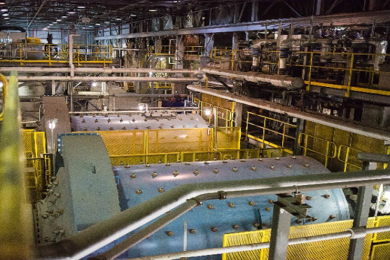New life for the Humboldt mill: design, construction, and commissioning as a modern Ni/Cu concentrator at Eagle mine is an interesting paper that was presented at last week’s SME Conference in Minneapolis by N. Michaelson, H. Staton and D. Stacey, all of Eagle Mine LLC.
Lundin Mining’s Eagle operation, located in Marquette County, upper Michigan consists of a mine and concentrator that process a Ni-Cu-(PGE) ore. The mine itself is an underground operation and the ore is trucked from the Eagle mine site 106 km to the Humboldt mill where both nickel and copper concentrates are produced. Operations began in 2014 and continued with an average production of some 23,000 t of Ni and 20,000 t of Cu per year for the first three years of operation.
The mill, currently operated by Lundin Mining, processes the nickel/copper ore from Eagle and performs the concentration through several stages of flotation. Originally built in 1954, Humboldt began operations as an iron ore processing facility, and was converted to a gold processing plant during the 1980s. Various groups owned the site after closure of the gold operation. Eagle purchased the mill in 2008 and invested more than $280 million to clean up historic mine waste and refurbish the plant.
The paper provides an overview of the ramp-up of the operation, and discusses some specific areas that went well and some that could have gone better during the design phase.
Coarse ore arrives from the mine and is stored in a building with a capacity of 10,000 t. Ore is crushed in three stages to a final product size of 100% passing 12 mm. Crushed ore is conveyed to the mass flow fine ore bins, which have a live capacity of 3,000 t.
Crushed ore is fed to two parallel 900 hp ball mills, charged with 3” high chrome grinding media, and ground, in closed circuit with hydrocyclones, to a p80 of 110 µm in the flotation feed. Soda ash is added to the mills based on process water hardness.
Cyclone overflow passes to the bulk conditioner where Sodium Isopropyl Xanthate (SIPX) and Methyl Isobutyl Carbinol (MIBC) are added. The slurry is pumped to the rougher bank for bulk flotation. Rougher concentrate is fed to a 500 hp vertically stirred regrind mill and is ground to a p80 of 50 µm, using 5/8” high chrome balls. Rougher tailings report to the tailings thickener.
The regrind cyclone overflow is sent to the single stage cleaner bank followed by two scavenger banks. The cleaner concentrate is pumped to the copper-nickel separation circuit. Cleaner tailings report to the tailings thickener.
In the copper-nickel separation circuit, the pH is raised to 11.5 and a copper concentrate is recovered from the bulk cleaner concentrate in two stages, namely the copper roughers and the copper cleaner columns. The concentrate from the copper flotation columns is the final copper concentrate. The tailings from the columns return to the head of the copper-nickel separation. The nickel concentrate is the copper rougher tailings stream.
Nickel and copper concentrates report to their respective high rate thickeners. The underflow from the thickeners report to the respective filter feed tanks. All thickener overflow water is pumped to the process water tank for recycling.
Concentrates are pumped to separate pressure filters to dewater and produce an 8-10% moisture final product for shipping. The filters discharge to the concentrate loadout bays and concentrate is collected with a front-end loader for loading into railcars and shipped to the customer.
Tailings are pumped from the tailings thickener to subaqueous deposition in the Humboldt Tailings Disposal Facility (HTDF).
“The start-up of operations at the Humboldt Mill was a success; it achieved and exceeded the projected targets for throughput, recovery, and product quality within the first year of operations. Paramount to this success story is the quality of people at Eagle, their engagement in problem solving, and willingness to try different things. These qualities permeate through the team today, and enabled the mill to overcome numerous challenges quickly. Eagle continues to operate at or above nameplate capacity, and has matured into an operation active in continuous improvement.”










